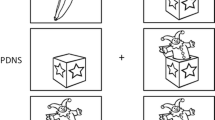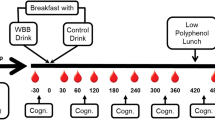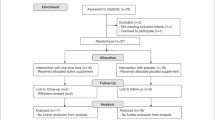Abstract
Purpose
As populations shift to include a larger proportion of older adults, the necessity of research targeting older populations is becoming increasingly apparent. Dietary interventions with blueberry have been associated with positive outcomes in cell and rodent models of aging. We hypothesized that dietary blueberry would improve mobility and cognition among older adults.
Methods
In this study, 13 men and 24 women, between the ages of 60 and 75 years, were recruited into a randomized, double-blind, placebo-controlled trial in which they consumed either freeze-dried blueberry (24 g/day, equivalent to 1 cup of fresh blueberries) or a blueberry placebo for 90 days. Participants completed a battery of balance, gait, and cognitive tests at baseline and again at 45 and 90 days of intervention.
Results
Significant supplement group by study visit interactions were observed on tests of executive function. Participants in the blueberry group showed significantly fewer repetition errors in the California Verbal Learning test (p = 0.031, ηp 2 = 0.126) and reduced switch cost on a task-switching test (p = 0.033, ηp 2 = 0.09) across study visits, relative to controls. However, no improvement in gait or balance was observed.
Conclusions
These findings show that the addition of easily achievable quantities of blueberry to the diets of older adults can improve some aspects of cognition.



Similar content being viewed by others
Abbreviations
- ANT:
-
Attention network task
- CVLT-II:
-
California verbal learning test, 2nd ed.
- DCF:
-
2′,7′-Dichlorofluorescin diacetate
- DHQ-II:
-
Diet history questionnaire II
- DS:
-
Digit span
- FES-I:
-
Falls efficacy scale-international
- FH:
-
Fall history questionnaire
- fMRI:
-
Functional magnetic resonance imaging
- GDS:
-
Geriatric depression scale
- HNRCA:
-
Human Nutrition Research Center on Aging
- PAQ:
-
Physical activity questionnaire
- POMS:
-
Profile of mood states
- PROF:
-
Computer/treadmill proficiency questionnaire
- TMT:
-
Trail-making test
- TST:
-
Task-switching test
- vMWM:
-
Virtual morris water maze
References
Miller M, Shukitt-Hale B (2012) Berry fruit enhances beneficial signaling in the brain. J Agric Food Chem 60(23):5709–5715
Zafra-Stone S, Yasmin T, Bagchi M, Chatterjee A, Vinson JA, Bagchi D (2007) Berry anthocyanins as novel antioxidants in human health and disease prevention. Mol Nutr Food Res 51(6):675–683
Huang W-Y, Liu Y-M, Wang J, Wang X-N, Li C-Y (2014) Anti-inflammatory effect of the blueberry anthocyanins malvidin-3-glucoside and malvidin-3-galactoside in endothelial cells. Molecules 19(8):12827–12841
Joseph JA, Shukitt-Hale B, Denisova NA, Bielinski D, Martin A, McEwen JJ, Bickford PC (1999) Reversals of age-related declines in neuronal signal transduction, cognitive, and motor behavioral deficits with blueberry, spinach, or strawberry dietary supplementation. The Journal of Neuroscience 19(18):8114–8121
Morris RG (1981) Spatial localization does not require the presence of local cues. Learn Motiv 12(2):239–260
Andres-Lacueva C, Shukitt-Hale B, Galli RL, Jauregui O, Lamuela-Raventos RM, Joseph JA (2005) Anthocyanins in aged blueberry-fed rats are found centrally and may enhance memory. Nutr Neurosci 8(2):111–120
Shukitt-Hale B, Bielinski DF, Lau FC, Willis LM, Carey AN, Joseph JA (2015) The beneficial effects of berries on cognition, motor behaviour and neuronal function in ageing. Br J Nutr 114(10):1542–1549
Kent K, Charlton K, Roodenrys S, Batterham M, Potter J, Traynor V, Gilbert H, Morgan O, Richards R (2015) Consumption of anthocyanin-rich cherry juice for 12 weeks improves memory and cognition in older adults with mild-to-moderate dementia. Eur J Nutr:1–9
Krikorian R, Shidler MD, Nash TA, Kalt W, Vinqvist-Tymchuk MR, Shukitt-Hale B, Joseph JA (2010) Blueberry supplementation improves memory in older adults†. J Agric Food Chem 58(7):3996–4000
Schrager MA, Hilton J, Gould R, Kelly VE (2015) Effects of blueberry supplementation on measures of functional mobility in older adults. Appl Physiol Nutr Metab 40(6):543–549
Miller MG, Hamilton DA, Joseph JA, Shukitt-Hale B (2014) Mobility and cognition: end points for dietary interventions in aging. Nutrition Aging 2(4):213–222
Laugero KD, Falcon LM, Tucker KL (2011) Relationship between perceived stress and dietary and activity patterns in older adults participating in the Boston Puerto Rican Health Study. Appetite 56(1):194–204
Paffenbarger RS Jr, Hyde RT, Wing AL, Lee I-M, Jung DL, Kampert JB (1993) The association of changes in physical-activity level and other lifestyle characteristics with mortality among men. N Engl J Med 328(8):538–545
Yardley L, Beyer N, Hauer K, Kempen G, Piot-Ziegler C, Todd C (2005) Development and initial validation of the Falls Efficacy Scale-International (FES-I). Age Ageing 34(6):614–619
Rogers RD, Monsell S (1995) Costs of a predictible switch between simple cognitive tasks. J Exp Psychol Gen 124(2):207
Monsell S, Yeung N, Azuma R (2000) Reconfiguration of task-set: Is it easier to switch to the weaker task? Psychol Res 63(3–4):250–264
Monsell S, Sumner P, Waters H (2003) Task-set reconfiguration with predictable and unpredictable task switches. Mem Cognit 31(3):327–342
Department W (1944) Army Individual Test Battery: Manual of Directions and Scoring. Washington, D.C
Delis DC, Kramer J, Kaplan E, Ober BA (2000) CVLT-II: California verbal learning test: adult version. Psychological Corporation
Wechsler D (1945) A standardized memory scale for clinical use. J Psychol 19(1):87–95
Wechsler D (1955) Wechsler adult intelligence scale: Manual. Psychological Corporation
Hamilton DA, Johnson TE, Redhead ES, Verney SP (2009) Control of rodent and human spatial navigation by room and apparatus cues. Behav Processes 81(2):154–169
Jacobs WJ, Laurance HE, Thomas KG (1997) Place learning in virtual space I: Acquisition, overshadowing, and transfer. Learn Motiv 28(4):521–541
Fan J, McCandliss BD, Sommer T, Raz A, Posner MI (2002) Testing the efficiency and independence of attentional networks. J Cogn Neurosci 14(3):340–347
Yesavage JA, Brink TL, Rose TL, Lum O, Huang V, Adey M, Leirer VO (1983) Development and validation of a geriatric depression screening scale: a preliminary report. J Psychiatr Res 17(1):37–49
McNair D, Lorr M, Droppleman L (1992) Revised manual for the Profile of Mood States. Educational and Industrial Testing Services, San Diego, CA 731:732–733
Lacritz LH, Cullum CM (1998) The hopkins verbal learning test and CVLT: a preliminary comparison. Arch Clin Neuropsychol 13(7):623–628
Lacritz LH, Cullum CM, Weiner MF, Rosenberg RN (2001) Comparison of the hopkins verbal learning test-revised to the California verbal learning test in Alzheimer’s disease. Appl Neuropsychol 8(3):180–184
Kaltreider LB, Cullum CM, Lacritz LH, Brewer K, Filley CM (1999) Brief Recall tasks and memory assessment in Alzheimer’s disease. Appl Neuropsychol 6(3):165–169
Vanderploeg RD, Schinka JA, Retzlaff P (1994) Relationships between measures of auditory verbal learning and executive functioning. J Clin Exp Neuropsychol 16(2):243–252
Tremont G, Halpert S, Javorsky DJ, Stern RA (2000) Differential impact of executive dysfunction on verbal list learning and story recall. Clin Neuropsychol 14(3):295–302
Hill BD, Alosco M, Bauer L, Tremont G (2012) The relation of executive functioning to CVLT-II learning, memory, and process indexes. Appl Neuropsychol Adult 19(3):198–206
Alexander M, Stuss D, Fansabedian N (2003) California Verbal Learning Test: performance by patients with focal frontal and non-frontal lesions. Brain 126(6):1493–1503
Stuss DT, Alexander MP, Palumbo CL, Buckle L, Sayer L, Pogue J (1994) Organizational strategies with unilateral or bilateral frontal lobe injury in word learning tasks. Neuropsychology 8(3):355
Brickman AM, Buchsbaum MS, Shihabuddin L, Hazlett EA, Borod JC, Mohs RC (2003) Striatal size, glucose metabolic rate, and verbal learning in normal aging. Cognitive Brain Res 17(1):106–116
Wasylyshyn C, Verhaeghen P, Sliwinski MJ (2011) Aging and task switching: a meta-analysis. Psychol Aging 26(1):15
Reimers S, Maylor EA (2005) Task switching across the life span: effects of age on general and specific switch costs. Dev Psychol 41(4):661
Dove A, Pollmann S, Schubert T, Wiggins CJ, von Cramon DY (2000) Prefrontal cortex activation in task switching: an event-related fMRI study. Cognitive Brain Res 9(1):103–109
Sohn M-H, Ursu S, Anderson JR, Stenger VA, Carter CS (2000) The role of prefrontal cortex and posterior parietal cortex in task switching. Proc Natl Acad Sci 97(24):13448–13453
Öberg T, Karsznia A, Öberg K (1993) Basic gait parameters: reference data for normal subjects, 10–79 years of age. J Rehabil Res Dev 30:210–210
Author information
Authors and Affiliations
Corresponding author
Ethics declarations
Ethical standards
This study was approved by the Tufts Medical Center Institutional Review Board and was performed in accordance with the ethical standards laid down in the 1964 Declaration of Helsinki and its later amendments. All study participants gave their informed consent prior to their participation in the study.
Conflict of interest
All authors read and approved the final manuscript. The authors declare that they have no conflict of interest.
Funding
U.S. Department of Agriculture, U.S. Highbush Blueberry Council, Tufts University.
Additional information
ClinicalTrials.gov Identifier: NCT01888848.
Rights and permissions
About this article
Cite this article
Miller, M.G., Hamilton, D.A., Joseph, J.A. et al. Dietary blueberry improves cognition among older adults in a randomized, double-blind, placebo-controlled trial. Eur J Nutr 57, 1169–1180 (2018). https://doi.org/10.1007/s00394-017-1400-8
Received:
Accepted:
Published:
Issue Date:
DOI: https://doi.org/10.1007/s00394-017-1400-8




